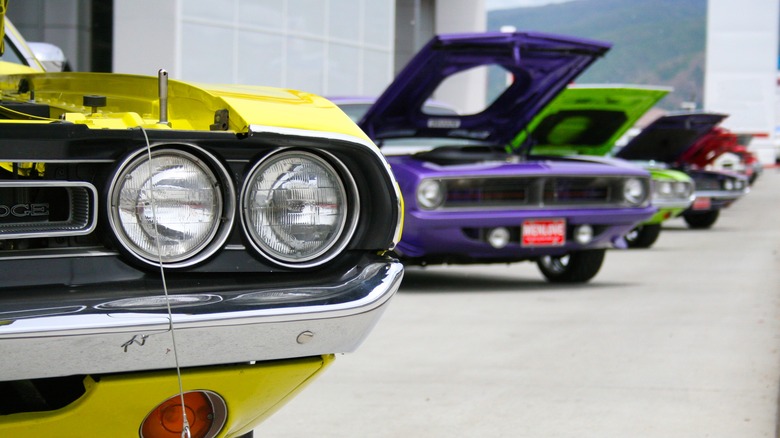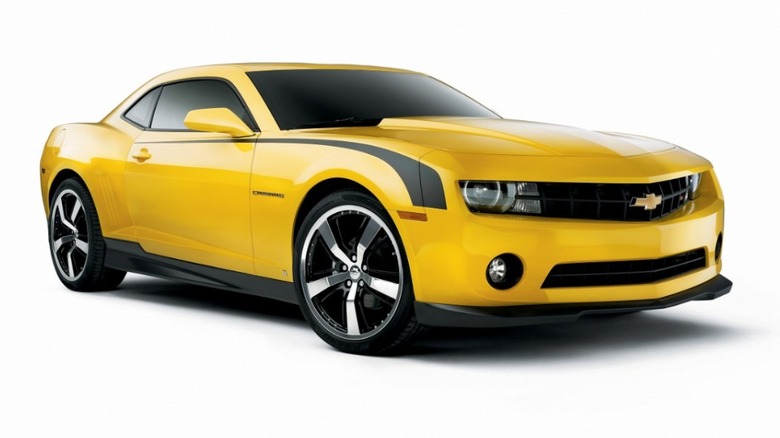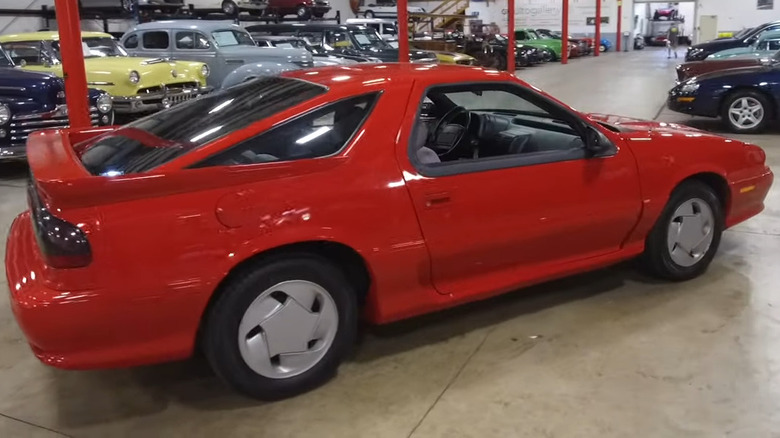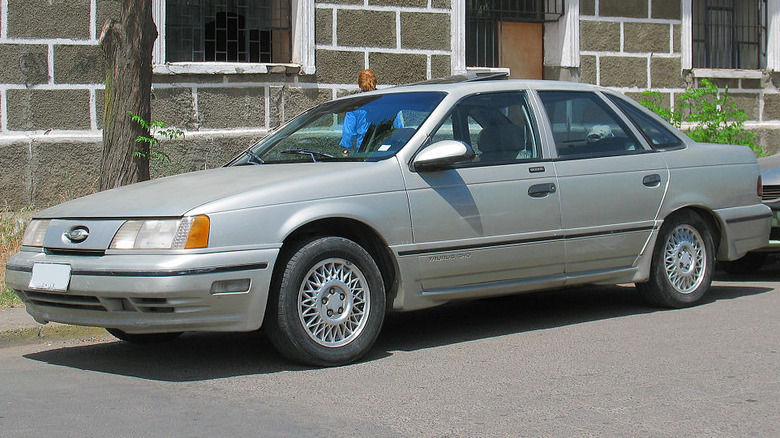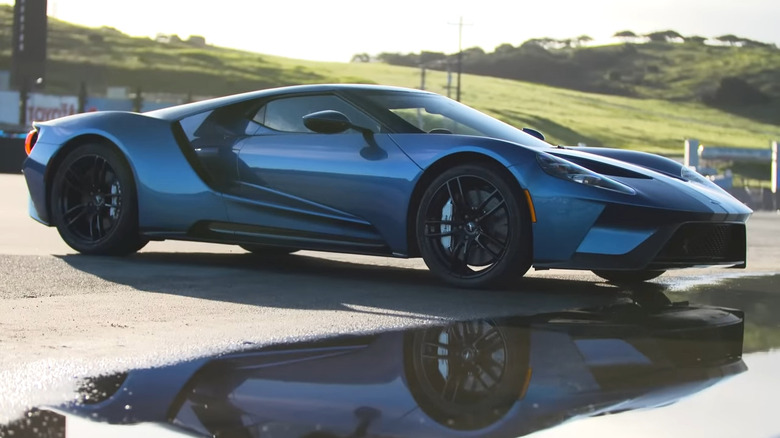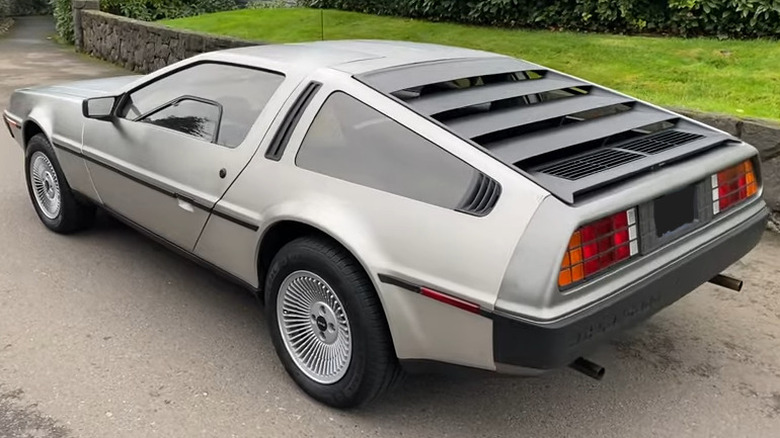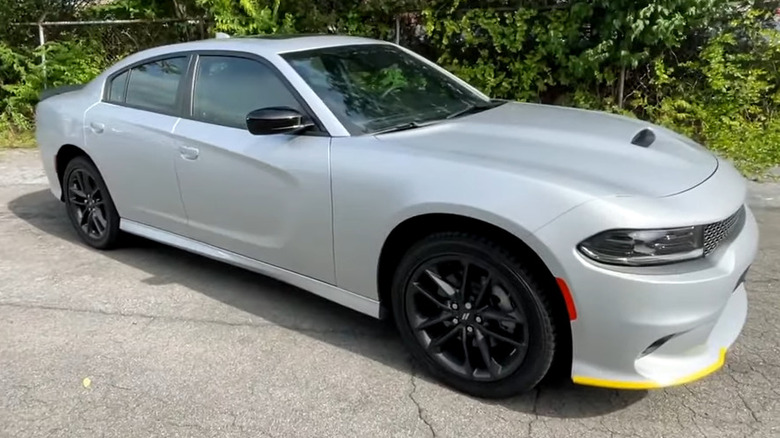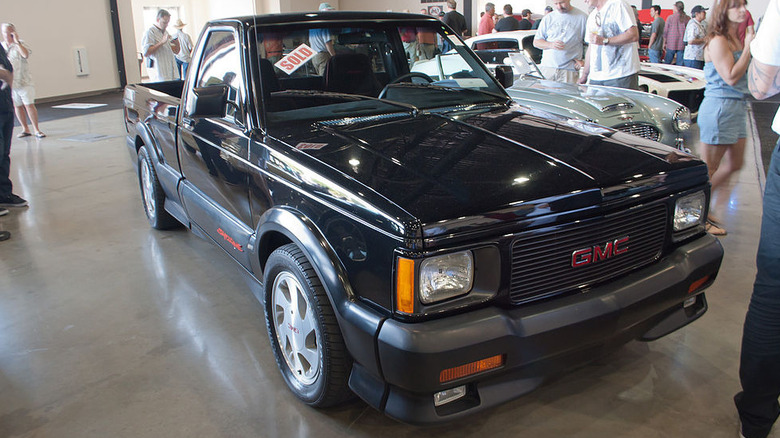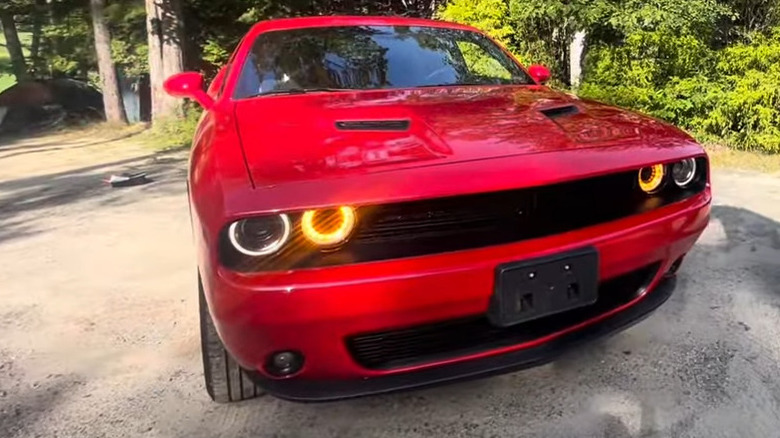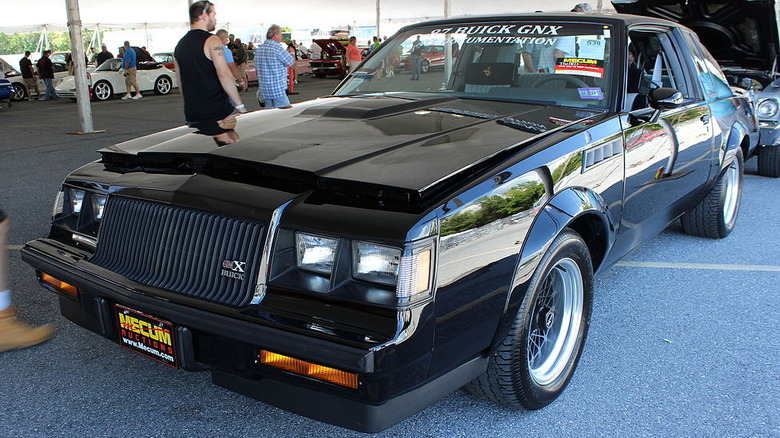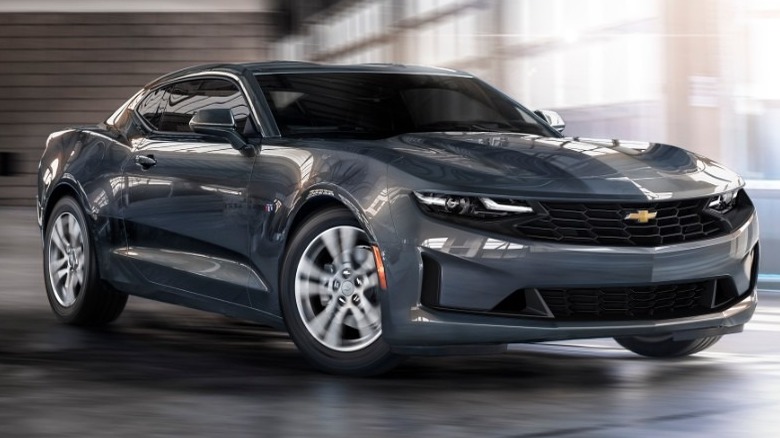10 Of The Coolest Muscle Cars With V6 Engines
The question, "What is a muscle car?" brings a set of specs and requisites to gearheads. American-made. Heavy steel. Straight lines. Hard edges. Two doors. Perhaps most importantly, the largest engines available under the hood. Muscle cars like the 1977 Pontiac Trans Am, the 1967 Shelby GT500, or the 1970 Pontiac GTO Judge.
Enthusiasts may argue that this list shouldn't even exist, as it should be exclusive to V8-powered metal monsters made in Detroit. However, we'd argue that the V6 engines that power the automobiles that we've collected continue the legacy established by those cars. Many of the vehicles in our collection could also beat several of those classic, traditional muscle cars one-on-one, despite their wild shapes and sizes.
This list will focus on one entry per model (with one exception) to add some variety to a list that would otherwise be exclusively populated by Camaros, Challengers, and Mustangs. That will add some entries that push the limits of the definition of a muscle car.
Then again, with those three models either being retired or radically altered soon, maybe that's a good thing.
2010 Chevrolet Camaro
The Chevy Camaro is a great place to start for our purposes. For years, there was simply nothing cool about a V6 muscle car. Don't believe us? Search for any review of a car with a V6 option from any year before 2000. Immediately, one is overwhelmed with vitriolic takes and no small hint of toxic masculinity. However, when the Camaro was revived in 2010, times had changed.
While classic Camaros are lauded for their powerful V8s and styling, the 2010 managed to get 304 horsepower out of a 3.6-liter six-cylinder engine. Capable of 0-60 in 6.1 seconds, the 3.6-liter V6 under the hood of this ride wasn't lacking in power — its 304 horsepower, while nowhere near the 426 of the V8 SS model, offered enough power and fuel efficiency to push some reviewers to prefer the six-cylinder option for daily driving.
The Camaro has been retired once again, with the last of the venerable muscle cars coming off the Michigan assembly lines in January of 2024. While it's unlikely we'll ever see another eight-cylinder monster like those of the past nearly 60 years, another six-banger or even an electric version may be in Chevrolet's future.
1992 Dodge Daytona IROC
When most people think of an IROC, the image that most often comes up is likely that of a 1985 Chevy Camaro IROC-Z, likely with a big V8 under the hood. But there was a period after 1989 when Dodge became the official sponsor of the International Race of Champions, and due to the peculiar way that the race was run, (each racer was given an identical car) it was decided that all competitors in the IROC would drive modified Dodge Daytonas.
While there are arguments to be made that the actual race cars were modified Camaros with Mopar engines, the rebrand meant IROC branding could be featured on street-ready Daytonas starting in 1990. A partnership with Mitsubishi birthed the 3.0-liter V6 that powered the 1992 Daytona, and a move in manufacturing plants for the next to last year of the model brought this rare version of the Daytona to the masses.
That relocation brought about several cosmetic changes to the Daytona. Gone were the pop-up headlights that had been a part of the Daytona since 1987; they were replaced with flush lamps in the redesigned, rounded front fascia. The rear end also received a new look, and the Pentastar emblem that graced the front of older Daytonas was replaced by the new Ram branding, which would end up breaking off into a separate lineup in 2009. The IROC came standard with a 3.0-liter V6, capable of producing 141 horsepower. This is not the most powerful engine by any stretch, but it has 20 mpg and costs around $4,000 less than its turbocharged stablemate.
1989 Ford Taurus SHO
The Ford Taurus has been credited as the car that saved the automaker from bankruptcy in the 80s. Its rounded edges, thoughtful interior design, and comfortable modified MacPherson suspension combined to make a vehicle unlike anything else on the market in 1985 and was wildly successful. (The incredibly catchy theme song didn't hurt, either.)
That success led Ford's Special Vehicle Operations division to push for a high-performance version of the Taurus. Conveniently, a prototype had already been made by frequent Ford collaborators Carron & Company. And while it didn't look that much different than a standard Taurus, the SHO (Super High Output) was a sleeper muscle car through and through.
The reputation' of the SHO's V6 is almost as legendary as the Taurus SHO itself. In a time when V8 Mustangs were only making 200 horsepower, Ford turned to Yamaha to modify Ford's Vulcan V-6 engine. The result was a 220hp, 3.0-liter mill that could take the Taurus 0-60 in 6.5 seconds, with a top speed of 143 miles per hour.
By 1989, the Taurus SHO was in production, and cost under $20k. Comparisons were made to the Mustang GT and Camaro IROC-Z, but the Taurus was simply more well-rounded as an affordable powerhouse that was as comfortable taking the kids to school as it was lining up at the track.
[Featured image by order_242 via Wikimedia Commons | Cropped and scaled | CC BY-SA 2.0]
2017 Ford GT
The GT has a fascinating history, one that moviegoers were introduced to in the film "Ford vs. Ferrari." After a purchase offer to Ferrari was turned down, a scorned Henry Ford II worked with racing design legend Carrol Shelby to take first, second, and third place (ahead of Ferrari) at the 1966 24 Hours of Le Mans with their GT40.
Fast forward to the 2015 North American International Auto Show, where Ford unleashed the Ford GT just in time for it to celebrate the anniversary of the GT40's win with a victory at the 2016 24 Hours of Le Mans.
If the definition of a muscle car is in the blocky aesthetics, this machine probably doesn't fit the bill. However, as a car powered by a twin-turbo EcoBoost V6, the Ford GT dropped jaws and wowed audiences at its unveiling and continues to impress wherever one is spotted on the road with its clean lines and aerodynamic curves.
A frankly terrifying 0-60 in 2.9 seconds gets drivers where they want to go, fast, and the twin-turbo boosted 3.5-liter EcoBoost engine produces 674 horses and 550 lb-ft of torque. It's American, it's got muscle where it counts, and it deserves its place on our list.
1981 Delorean DMC-12
It's a car more well known for its IMDB page than its racing history, and one that is instantly recognizable to nearly anyone anywhere in the world. Designed by Giorgetto Giugiaro, a man who dreamed up cars like the Lotus Esprit and Ferrari 250 GT SWB Bertone, the 1981 car best remembered for leaving flaming tracks in the parking lot of the Twin Pines Mall in "Back to the Future" was a muscle car without the muscle. What it lacked in power, however, it made up for in style.
The Delorean DMC-12, more commonly known simply as a Delorean, actually went through engines from Wankel, Ford, and Citroën before settling on the fuel-injected V6 built by Peugeot-Renault-Volvo. That 2.8-liter engine produced 132 horsepower, enough to get the Delorean with a five-speed manual transmission from 0-60 in 8.8 seconds. While the DMC-12 was rated at about 108 mph, the speedometer only went up to 85 – not even enough to get that flux capacitor humming.
While kind reviews on release devolved into harsher critiques in recent years, the DMC-12 was never built to be a racer, with safety and style taking priority over power. Still, if one were to judge strictly on vibes, the Delorean with the stainless steel body would always make the cut. After all, what are gullwing doors if not a muscle car flex for the '80s?
2023 Dodge Charger GT AWD Blacktop Special Edition
Muscle cars are cool, but they do have some drawbacks. For one thing, they're typically gorgeous pieces of machinery, the kind of thing one wouldn't take into bad weather. For two, most muscle cars are rear-wheel drive, which might not be the best choice for a snowy drive to the supermarket. However, with the final generation of the Charger, Dodge found a solution for both of these issues.
A V6 Charger may be sacrilege to some, but this muscle car has been outfitted in a way that more than makes up for the smaller engine. All-wheel drive is not an option for the V8 Charger, but it is available for the V6, making this muscle car a daily driver in even the harshest climates. The GT Blacktop trim features several of the same Scat Pack features such as a performance hood, ground effects, and a spoiler. And with the 807-horsepower, V8 Charger SRT Hellcat Redeye Jailbreak already looking scarce, the GT may be the last chance for many to own any gas-powered Charger for the foreseeable future.
The engine powering the Charger GT is reasonably powerful – it's a 3.6-liter V6 pumping out 300 horsepower and 264 lb-ft of torque. It's also one of the smarter muscle cars on our list, utilizing a front-axle disconnect system to improve fuel economy when all-wheel drive isn't necessary. Combine that with an impressive suite of performance monitors in the touchscreen system and customizable cluster display, and you've got a fun racer that provides a good balance of power and performance.
1991 GMC Syclone
The 1991 GMC Syclone was an all-wheel-drive pickup with a four-speed automatic and a V6. Not impressed? This little muscle truck once street raced a Ferrari 348ts in a straight line — and won.
This pickup was no slouch, made at a time when GMC lost its collective mind and was willing to try something incredibly cool. Initial plans of installing the engine that powered the 1987 Buick Grand National (more on that later) had to be scrapped due to pricing concerns, so GMC tapped Production Automotive Services (PAS) for some help.
PAS, the company that worked on the 1989 Pontiac Turbo Trans Am, took the GMC S-15's stock engine, modified it, and combined it with a Mitsubishi turbocharger. The result: 280 horsepower, 350 lb-ft of torque, and a turbocharged and inter-cooled 4.3-liter Vortec V6 engine, all wrapped up in a package that looked more at home on the farm than the track.
There have been attempts to recreate this unicorn of a muscle pickup. The Ford Lightning F150, Dodge Dakota R/T, and even the spiritual successor to the Syclone, GMC's own Typhoon, have all channeled the magic of that unassuming little pickup, but it was the Syclone that started it all.
[Featured image by skinnylawyer via Wikimedia Commons | Cropped and scaled | CC BY-SA 2.0]
2023 Dodge Challenger SXT
While not technically part of the "Last Call" series – the line of commemorative Challenger packages that includes the Demon 170, Swinger, and Black Ghost – the SXT was still one of the last of its name ever made. It also gets to take advantage of a lot of the perks that Dodge is rolling out for this last generation of muscle cars, including black-painted wheels, 20-inch tires, and a wide selection of classic colors like Plum Crazy, SubLime, and Go Mango.
Even though the SXT is considered the "low end" of the Challenger spectrum in terms of sheer power, the 3.6-liter V6 outputs 303 horsepower and gets a combined 23 mpg, although that gas mileage drops a bit if one opts for AWD. The SXT is only available in automatic, which is a bit of a letdown for a muscle car of any type, but reviews say that the Torqueflight eight-speed transmission is actually an upgrade from the less responsive stick shift.
This sounds like we're down on the Challenger SXT, but that's far from the case. A V6, all-wheel drive, automatic that looks as good as the '23 Challenger and still has over 300 horses under the hood is still a party in our book.
1987 Buick Grand National GNX
When it was announced that the Buick Regal, and Regal Grand National, were being discontinued in 1987, many folks were heartbroken. What started as an appearance package in 1982 became a singular package by 1984 – some called it the last American muscle car. However, times changed, and a 3500-pound slab of metal just wasn't as practical as newer designs in the gas-conscious '80s. Still, the big rear-wheel-drive beast was beloved by many, and the company's engineers weren't about to let the Regal go out without a bang. The GNX was that bang.
Only 500 of these GNX Buicks were produced, and they were incredible. The turbocharged, intercooled, 3.8-liter V6 that powered this big, blocky muscle monster already produced 245 horsepower, but Buick wanted the last of this model to have a grand finale, so they allowed McLaren to tune and modify that engine. Changes to the turbo, intercooler, suspension, and exterior were also implemented. The retooled engine was rated at 300 horsepower, output 380 lb-ft of torque, and could get to 60 mph in 4.7 seconds. One thing that didn't change from the Grand National to the GNX, however, was the color selection: the choices were black or another vehicle.
The '87 GNX is legendary among folks in the know, both for its gorgeous looks and its fascinating engine design. It's rare, heavy, powerful, and the last — and only — run of its name.
[Featured image by Buick GNX via Wikimedia Commons | Cropped and scaled | CC BY-SA 2.0]
2023 Chevrolet Camaro
The 2023 Camaro might arguably be the last muscle car standing, although the 2024 edition is likely the last dinosaur-powered version of the venerable muscle car. Dodge's Challenger and Charger bowed out with their 2023 "Last Call" and the Mustang has gotten a complete (and controversial) redesign. However, there is an importance to appreciating things while they are still around, and the V6-powered '23 Chevy Camaro does not disappoint.
The optional 3.6-liter V6 engine that powers the LT versions of the Camaro provides 335 horsepower and 284 lb-ft of torque. Unfortunately, some constraints from the worldwide parts shortage of the early 2020s forced Chevy to reduce the number of LT1 and LT2s outfitted with the V6.
Paired with a six-speed manual transmission, reviews compliment the car's solid structure and handling. The six-cylinder Camaro also gets a respectable 16 mpg in the city, and 26 on the highway, regardless of transmission choice. The interior looks cool, with comfortable seats up front and customizable ambient lighting. It's not exactly built for passengers or cargo, as it's got limited space for either; however, as a muscle car for the modern age, this thing rips.
